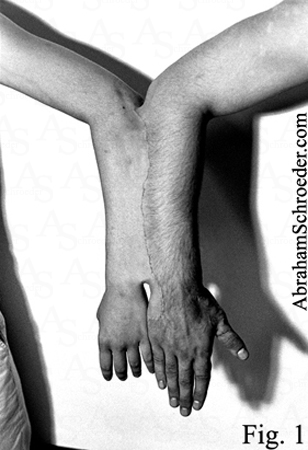Conjoinery
The article below explains the images.
Use the slider or arrow keys to scroll right or left in the gallery. Final printed images do not contain watermarks.
Conjoinery
|
|

Conjoinery Text and photographs by Abraham Schroeder Surgery was completed 19 November with no complications by a plastic surgeon specializing in tissue reconstruction. Antibiotics and immunosuppressives were taken for the duration of the experiment and the patients remaind conjoined for 6 months before deciding to separate. The separation was completed on 26 April, 1996 by the same surgeon. Nerve damage was minimal, although both patients did lose some sensation in their little fingers and along the scars. Because of existing scar tissue from an accident a large amount of skin had to be removed from the male patient's hand during the initial surgery so skin-grafts were necessary for both patients during reclosure.  The second case was done in February of 1997 by an understudy of the surgeon who did the first conjoinery. This time the forearms and hands of two women, ages 23 and 25, were linked for a period of 10 months. (Fig. 2) The two were not romantically involved, but had known eachother since childhood. Physical and psychological testing were done, and the two were tied together for 2 weeks prior to the surgery. Complications were minimal, although grafts were used on the hands after separation and there was some loss of sensation along the length of the scars.  In 1996 one of the women had joined her forearm to that of a male friend by a row of peircings in the skin, but they remained together for only a few hours. Since February of 1997 the joining of bodies has become more frequent and the techniques have been refined to some degree. Procedures involving legs, backs, and heads, have also been performed. More complicated surgeries involving deep tissue and bone have also been undertaken with some success. The thigh conjoinery shown at the top of the page and the finger and facial conjoineries shown here were all completed in autumn of the year 2000. 
 |
